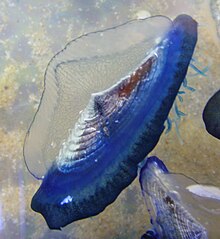Sailing jellyfish
| Sailing jellyfish | ||||||||||||
|---|---|---|---|---|---|---|---|---|---|---|---|---|

Sailing jellyfish ( Velella velella ) |
||||||||||||
| Systematics | ||||||||||||
|
||||||||||||
| Scientific name of the genus | ||||||||||||
| Velella | ||||||||||||
| Lamarck , 1801 | ||||||||||||
| Scientific name of the species | ||||||||||||
| Velella velella | ||||||||||||
| ( Linnaeus , 1758) |
The sailing jellyfish ( Velella velella , syn .: V. lata Chamisso & Eysenhardt, 1821) is a cnidarian (Cnidaria) belonging to the hydrozoans . It is the only known species in the genus Velella .
Because of its construction, the jellyfish is also called "sailor before the wind" or "Sankt-Peters-Schifflein" in German (Petrus: patron saint of fishermen).
features
The hydroid polyps form colonies of animals floating in the water column , which look like small rafts with sails. The raft is flattened, elliptical to oval with an obliquely (lengthways diagonally), approximately triangular sail that runs obliquely like the letter N or in a mirror image of it over the somewhat elongated raft. It is up to 4 cm long, 2 cm wide and approx. 1 cm high. The raft is supported by a chitin structure, which is covered by fabric. There are mirror-image right and left rafts in previously unknown ratios. The survey of a large number of animals stranded together can give a wrong idea of the overall distribution of the species, because animals with the same sail position have drifted to the same stretch of beach mechanically. The right-left characteristic of the feathering position in Velella can therefore be distributed quite racemically, i.e. in a ratio of around 50:50, although a sample shows that the feathering position is the same. Because with passive sailing "in front of the wind", a pre-sorting takes place depending on the sail position: rafts with the sail N-position, as in the picture above or in the picture of the stranded animals in the example in the front left, are moved to the right (" to starboard "). - The edge is soft and flexible. The chitin structure has concentric air-filled chambers that keep the raft in suspension. In living animals, the raft is deep blue. The mantle tissue is traversed by a network of endodermal canals. In the center of the underside sits a single large feeding polyp (also called "Sipho"). It is surrounded by a ring of medusa-producing feeding / sexual polyps (gastro-gonozoids). This ring is in turn bordered by a band of defense polyps (dactylozooids). The central feeding polyp is broad-shaped with an elongated hypostome; it has no tentacles or Medusa buds. The feeding / defense polyps are spindle-shaped with a thickened mouth region; They too have no tentacles, but warts on which are concentrated nettle cells . These stinging cells are concentrated in the distal half. Groups of Medusa buds grow on the proximal half of these feeding / sexual polyps, starting from short blastostyles. The Medusa buds are colored yellow-olive by symbiotic bacteria. The marginal defense polyps are relatively long, ovoid in cross section. The stinging cells are concentrated in two ligaments that sit on the narrower sides of the defense polyps. You don't have a mouth.
The medusa has four radial channels and two pairs of opposing perradial tentacles, a short adaxial tentacle and a long abaxial tentacle. The tip of the tentacles shows concentrations of nettle cells. Two perradial buds are without tentacles. The manubrium is conical with an approximately square base. The mouth is drawn out like a tube. The gonads are irregularly distributed perradial and interradial. The exumbrella has four rows of nettle cells. The cnidome consists of rounded stenotheles, macrobasic euryteles and atric haplonemes .
Geographical distribution and way of life
Sailing jellyfish live worldwide in tropical and subtropical seas (also in the western Mediterranean ), on the surface of the high seas . Occasionally they also appear on the west coasts of the British Isles and Ireland. Sailing jellyfish cannot actively move, but are driven by the wind. In storms, they can be washed up in large numbers on the coasts. Sailing jellyfish likely feed on small planktonic organisms.
Enemies
The enemies of the sailing jellyfish include the pelagic snail Glaucus atlanticus, which belongs to the nudibranch, and the violet snail (Janthina janthina).
Reproduction
The sexual polyps of the sailing jellyfish tie off asexual male and female medusas, which sink to great depths (up to 1000 meters) and spawn there. Thanks to a drop of oil in the body, the larvae rise to the surface of the water, where they develop into adult sailing jellyfish. This can create gigantic swarms that have already reached lengths of 260 kilometers in the Atlantic.
Individual evidence
- ↑ Article on mare online ( Memento of the original from December 4, 2016 in the Internet Archive ) Info: The archive link was inserted automatically and has not yet been checked. Please check the original and archive link according to the instructions and then remove this notice.
- ↑ The Marin Life Information Network: Distribution of the Velella velella off Great Britain and Ireland ( Memento of the original from March 25, 2015 in the Internet Archive ) Info: The archive link was inserted automatically and has not yet been checked. Please check the original and archive link according to the instructions and then remove this notice. .
literature
- Jean Bouillon, Cinzia Gravili, Francesc Pagès, Josep-Maria Gili and Fernando Boero: An introduction to Hydrozoa. Mémoires du Muséum national d 'Histoire naturelle, 194: 1-591, Publications Scientifiques du Muséum, Paris 2006 ISBN 978-2-85653-580-6
- Matthias Bergbauer, Bernd Humberg: What lives in the Mediterranean? Franckh-Kosmos, Stuttgart 1999, ISBN 3-440-07733-0

